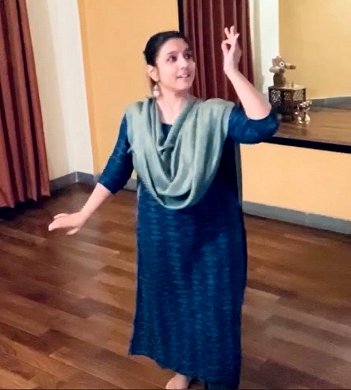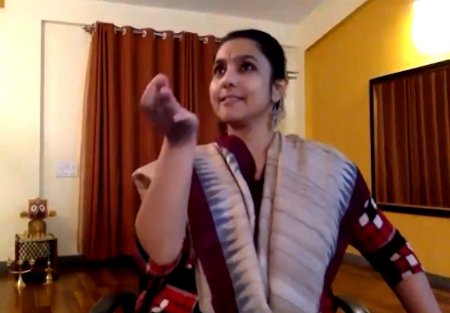
|   |

|   |
 e-mail: ukb7@rediffmail.com Kathak and Dhrupad: Hand in hand September 6, 2020 Both Kathak dance and Dhrupad music are steeped in hoary history of this subcontinent. Kathak having been danced in the Mughal courts is well documented, with the Agra Fort (and perhaps Delhi's Purana Qila) having resonated to the ghungrus of the petite dancers. While Emperor Akbar was known to have been privy to this dance, Jehangir was reputed to have conceived the costume of Kathak as is known today. On the other side, Srimad Bhagavat mentions Dhruvapad and Krishnapad in synonymous terms, sung devoutly in Vrindavan from the 15th century onwards. While Akbar had Govind temple built in his time, Shri Chaitanya sent Jeev Goswamy and Roop Goswamy all the way from Bengal to restore the Vaishnava temples in Vrindavan. These ace disciples of Mahaprabhu were instrumental in building the Radharaman temple in the 16th century, still redolent with Ras Leela in Kathak form alongside Bhagavat music. As an interesting aside, one can note that only the male style of Kathak is invoked in Vrindavan, although there is an anecdote ascribed to Princess Mira - while seeking audience of Jeev Goswamy and being spurned by his followers that the saint never met women -- with the famous rejoinder: "But there is only one male in Vrindavan, namely Krishna, and the rest are only women!" The idol Radharaman is serenaded every evening with a melodious lullaby on flute, to be put to sleep, while generally the temples remain alive with music and dance in their precincts throughout the day. The noted scholar-dancer Parwati Dutta, who is the dean of performing arts in the Mahagami University at Aurangabad and directs the Mahagami Gurukul for teaching diverse forms of the performing arts, is working for some years on a most innovative form of what she calls "Dhrupadangi Kathak." This is what she has to say on the subject, "Travelling back in history and retracing the Kathak journey, I came across a tradition of symbiotic relation between gayan-vadan-nritya in the form of Dhrupad Nritya that flourished during the reign of Mansingh Tomar in the 15th century. He had developed a dance form combining the Desi and Suddha, combining the Shastraic details and the regional flavor. This is evident in Sahasaras which is a compilation of 1000 Dhrupad song-texts of Bakhshoo, a musician who collaborated with Mansingh Tomar in the refinement of Dhrupad. Dance is culturally and historically coded and so reading and making dance is also based on hermeneutic and discursive codes." Further, "My choreographic attempts with Dhrupad Nritya investigate its relations to the moving body and the implications of the melodic ambience. There are references of Kathak of the medieval period being performed on 'padas', 'prabandhas' and Dhrupad in temples and even in the royal courts between 14th to 18th century. Ain-i-Akbari by Abu Fazl (1593) interestingly records the Dhrupad form of music and the dance of that region with many detailed references of the 'gat' and movements of Kathak. Pakhawaj accompaniment creates the most appropriate and elating rhythm support with its sonorous resonance that aesthetically compliments Kathak through re-sound variations in movement flow and the use of force, tension, and weight through many levels of consciousness - reflective and pre-reflective bodily awareness." And finally, "Most of my choreographic works and performances have also been based on bandishes (lyrics) of Tansen, medieval and other poets and composers reminding of the 'Ganga-Jamuni tehzeeb' (the confluence of Hindu and Islam), while some are reflections of the Sufi thought from the medieval period. The dance movements are adapted deliberately as heavy and gliding with dignity and poise coupled with dense patterns of tatkaar. Attempt to revive the ancient chaal and gat like ibaadat-ki-gat, duaa-ki-gat, etc, give a refreshed image of Kathak of the Mughal period, while the 'tribhangi sthaanak' of Natwari is a reminder of the Hindu vision of this dance form. Thus, Dhrupad becomes a guiding thread towards rejuvenation of this lost world of Kathaakars, Darbari Kathak and the one from the temples of North India." As stated above, Dhrupadaangi was the word coined by Parwati to explore and present the above ancient form of dance and music that stemmed from the Dhrupad tradition and the music-taal-movement sensibilities that co-existed with Dhrupad Parampara in the medieval period. Dhrupadaangi Kathak was, according to her, an attempt to revive the lost aspect of Kathak examining the aspects from the oral tradition and prayog, and researching the medieval references and resources in texts, paintings, sculpture and literature. The existing method of Kathak dancing to Dhrupads commonly seen, deals with only the dance delineation to the bandish without the inclusion of the alap-jod-jhala, which forms the philosophical and musicological basis of the Dhrupad genre. Parwati also observes that the Dhrupad singing is not explored much when incorporated for dance which limits the scope of the musical form. With these aspects in mind, in the mid 1990s she attempted initiating an authentic and ancient form of Dhrupad Nritya by incorporating the alap-jod-jhala-bandish-upaj aspects of the Dhrupad idiom and also redefining the Dhrupad aesthetics in dance by reviving and re-inventing the medieval movement vocabulary like the ancient lesser known taals, rare dance gaits 'gat', pakhawaj centric rhythm explorations and the internalization of the sonorous, esoteric and profound aura of the Dhrupad tradition.  In the online 5-day Mahagami Workshop, conducted on 16-20 August, Parwati worked on a new Dhrupad style adapting to a Sanskrit shloka from Kalidasa's Meghadootam. The verse was composed in raag Miyan Malhar and Sool taal. She sensitized the participants towards gestural exploration with Alap and Jod. She also demonstrated and taught them how to perceive the body, its bindu, its bearing and then the gestural flow in accordance to each segment of Dhrupad - the alap, jod, bandish and rhythmic compositions. There were few rare chaal taught by her to explain the gait to depict the clouds, the yaksha, the birds, the breeze. She also stressed on the internalization of a movement by first working on stillness by meditating on the breath, the body and the inner expression. This critic was invited to be an online observer on the fifth (and final) day of the workshop and was struck by the intense involvement of the participants. They were shown both the theatrical potential and choreographic visualization of the cloud by Yaksha; the clear duality of Yaksha's visage and the floating cloud; their own interpretation and enactment sought all the time; and the constant use of recapitulated knowledge as taught on the previous days. As Parwati explained, "I tried sensitizing the participants towards de-humanizing a textual content, exploring multi-layered meaning, working on bodily manifestation of an alap-jod-jhala through combining body consciousness with breath, re-imagining and re-aligning to the core, the centre and the intuitive response mechanism with music. I share with them how there are 4 layers of thinking about a dance rendition - Body, Bearing, Becoming and then Being. There are passages where I am trying to explain the multi-layered aspects of each line of Meghadootam and how the dhrupad and pakhawaj sensibilities can be explored. After 1 hour 45 min, the participants shared their thoughts and feedback about the workshop." Here is the link of the video  Sanskrit verse from Meghadootam adapted for the Dhrupad: mandam-mandam nudati pavanaś chanukūlo yathā tvām vāmaś chaayam nadati madhuram chātakas toyagrdhnuh | garbhādhānakshamaparicayān nūnam ābaddhamālāh sevishyante nayanasubhagam khe bhavantam balākāh || Meaning: As a favoring breeze drives thee ever slowly forward, And thy companion the chataka warbles sweetly here on the left, Surely the hen-cranes, for the intimacy that can make them fertile, Will attend, forming a garland in the air; in thee their eyes rejoice. The international profile of the participants was also very striking, comprising Sufi Raina - San Diego; Nidhi Mittal - Jalandhar; Antara Datta - Cleveland; Siddhi Goel - Delhi; Pallavi Sheikh - New Jersey; Krupa Tendulkar - Mumbai; Salonee Shatagar - USA; Sreelata J - Bangalore; Dr. Harpreet Kaur - Delhi; Akshi Sangra - Delhi; Hemakshi - Daman; Sheetal - Mahagami Gurukul; and Shreeya - Mahagami Gurukul. The workshop was aimed at senior dancers and dance teachers.  Dr. Utpal K Banerjee is a scholar-commentator on performing arts over last four decades. He has authored 23 books on Indian art and culture, and 10 on Tagore studies. He served IGNCA as National Project Director, was a Tagore Research Scholar and is recipient of Padma Shri. Post your comments Please provide your name and email id when you use the Anonymous profile in the blog to post a comment. All appropriate comments posted with name and email id in the blog will also be featured in the site. |